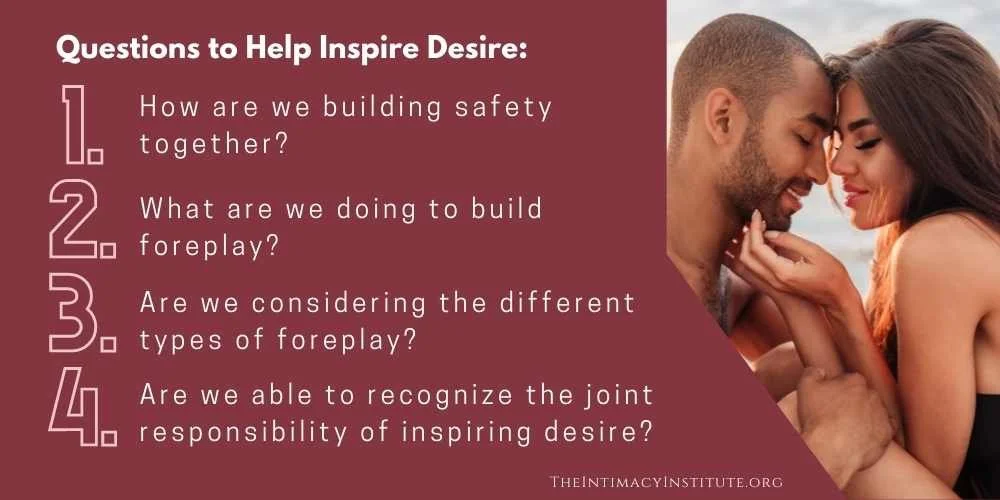Finding Satisfaction and Pleasure
Desire discrepancy in couples
Dr. Jenni here! I recently had a talk with Michele Forsberg from Feminenergy.net, a physical therapist for women who experience pain through sex. It was a great conversation, and we covered quite a few things so check out the video below.
But I want to discuss a little more about something that came up as a big deal for a lot of Michele’s clients, and honestly a lot of my own clients: desire discrepancy.
What is desire discrepancy?
Desire discrepancy is what I call the aspect of every couple’s relationship where, as Michele put it, one is “up here” and another is “down there” when it comes to their desire for sex. You know what I mean, where one person has more desire for sex than the other. It’s sometimes a symptom of relationship issues, and sometimes it’s the cause of the issues.
Usually, people will come to see me when it’s gotten really severe. It’s started to really affect the relationship, but what I typically tell them is that it’s something that must be solved for an effective, satisfying relationship to occur.
It also takes two to solve it. It’s not just the woman’s problem, it’s not just the man’s problem. When we talk about desire discrepancy, in a lot of cases we’re generalizing to talk about heterosexual relationships, by the way. This isn’t to say that there can’t be desire discrepancy in homosexual couples, but it is physiologically different for men and women — which is why we should talk about it!
So, in our partnerships with our significant others, we have a responsibility to inspire desire in our partner.
We need to consider a few things:
How are we building safety together?
What are we doing to build foreplay?
Are we considering the different types of foreplay?
Can we recognize that the issue isn’t just the woman’s fault, please?
It isn’t just a woman’s issue
So this is an important aspect. We know that society has put a lot of pressure on women throughout the centuries for their role in the bedroom. It’s a common joke that women won’t want to have sex and make excuses, right?
“Oh I have a headache”… it’s just a common trope.
Your desire is your desire, and it’s totally fine. What you need to do is find satisfaction and pleasure in a pressure free way with your partner, whatever that looks like. However that looks like for you both.
If a woman is finding that her desire is less than her partner’s, let’s not pressure her to do things anyway, but to explore ways that she can heighten her own arousal in a pressure free environment.
Doing away with the generalizations and stereotypes when it comes to roles in the bedroom will allow you to find pleasure in a way that works for you and your partner, not just what you’ve been told by society!
Pressure free
Pressure is something that can be a real mood killer for both halves of a couple. Pressure from work, pressure from family, pressure from religion. There are lots of ways that we find pressure and we have to consider that both people in a relationship have to take ownership for their end.
So, a man may need to manage his arousal more: self pleasure more, do more in foreplay, consider emotional foreplay as well as physical foreplay. And, again in a hetero relationship, the woman may need to take responsibility for her arousal and desire.
But we have to remember that the brain is the biggest sex organ, though. Michele said “it happens between the ears, not the legs”, and we laughed because it’s true.
What this means is that basically if we like our partner and we make time for it, crawl into bed and take off our clothes, things will happen. But we need to prioritize taking off our clothes.
Prioritize taking off your clothes
If we consider ourselves too busy, too tired, and we’re squeezing in romantic time with our partners at the end of the night when we’re completely worn out from the day… then it’s no wonder there’s a desire discrepancy between men and women.
Men have more testosterone, on average, than women and the testosterone hormone is like a quick-start tool for arousal. It’s much easier to go from a state of no arousal to a state of full arousal for a man because of that hormone in their system, bouncing around freely.
So, if we take the time to be together at night, just for 30 minutes to hang out, to kiss, to talk and touch, and cuddle… we’ll find that things slowly evolve.
Spontaneous passionate experiences are not what most couples have the majority of the time. Once in a blue moon, great! On vacation, great! But a regular sex life is a maintenance of sex that has a slow origin. That’s okay.
Sex needs relaxation
Desire discrepancy can creep into our relationships because of many different things, but a big aspect is that we’re not relaxed. Stress at work, or in daily life at home if we’re looking after the baby or young kids, can really make it difficult for us to relax. If we’re not relaxed, we’re not able to easily get aroused.
So these negative emotions of stress, anger, exhaustion are making it much, much harder for couples to balance their desires because it’s harder to reach a state of arousal. By prioritizing calm, relaxing times together, such as at night when we’re cuddling before bed, we can create a space for sex that is pressure free.
A method of fixing desire discrepancy
So we’ve identified there’s an issue, we know we want to solve the problem. What can we do about it?
I asked you, earlier, to recognize that there’s two halves to this in a relationship and everyone needs to take responsibility for their own desire.
Challenging yourself to find what turns you on, and knowing what you need to access yourself is key. There are actionable ways you can discover how to get yourself aroused and feel less drowned in day to day issues.
Trying things like wearing clothes that make you feel attractive or dancing to music that puts you in a carefree mood can help get you in a place where your desire can match your partner’s.
Knowing what you need to access yourself is key.
You know you need to be out in nature to recharge and be ready for arousal? Go for a hike or walk in nature. You like to wear something to get yourself in the mood? Put it on, make sure it’s ready on the night you’re trying to get excited.
It can work, but it takes a conscious effort to fix. Desire discrepancy is something that most couples will experience at one point or another, but it’s not something that needs to bring a relationship down.
Want to learn how to communicate effectively and build trust and connection through emotional, physical, sensual and sexual intimacy? Check out our Road to Intimacy Roadmap E-Course for couples!


